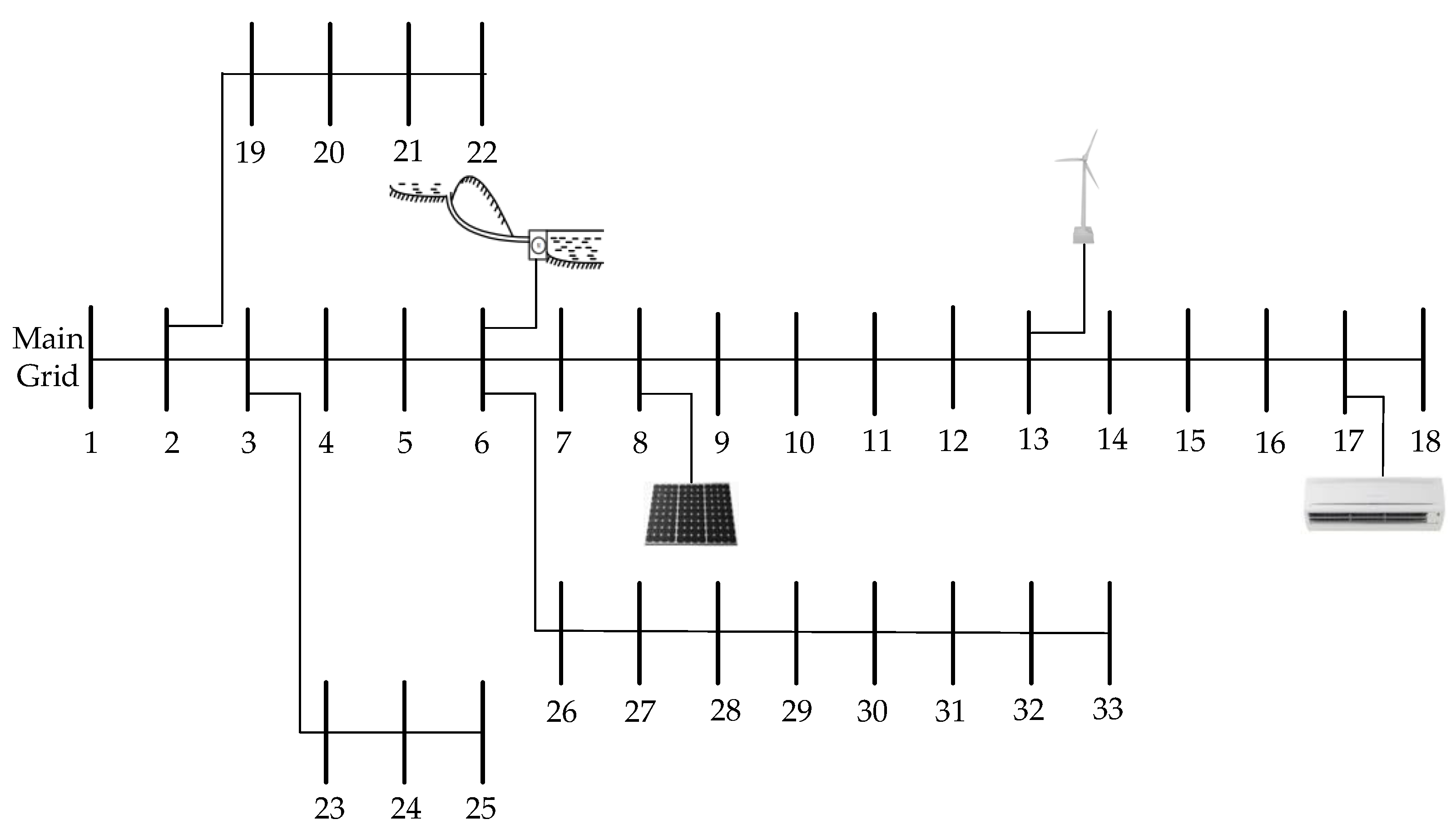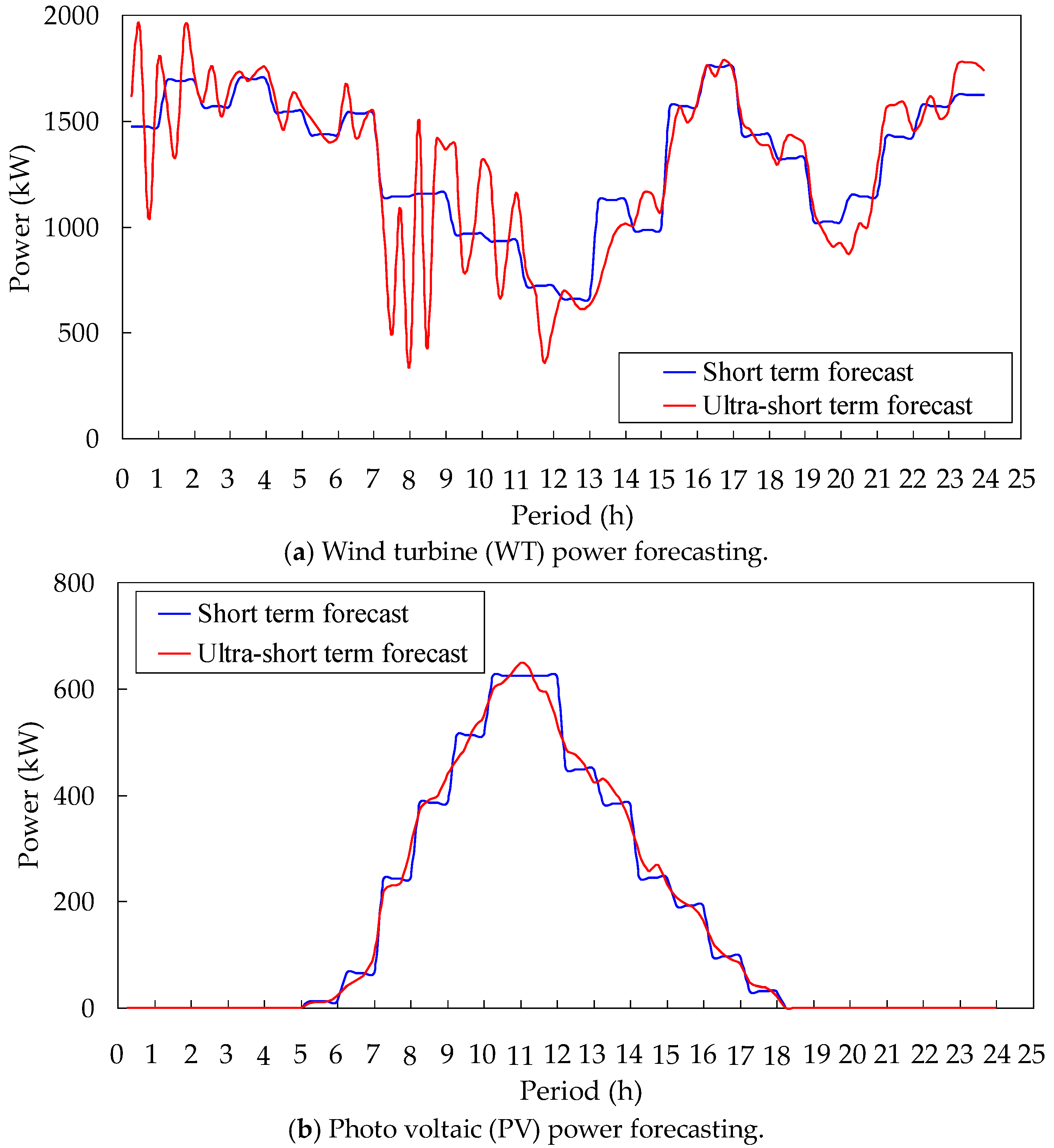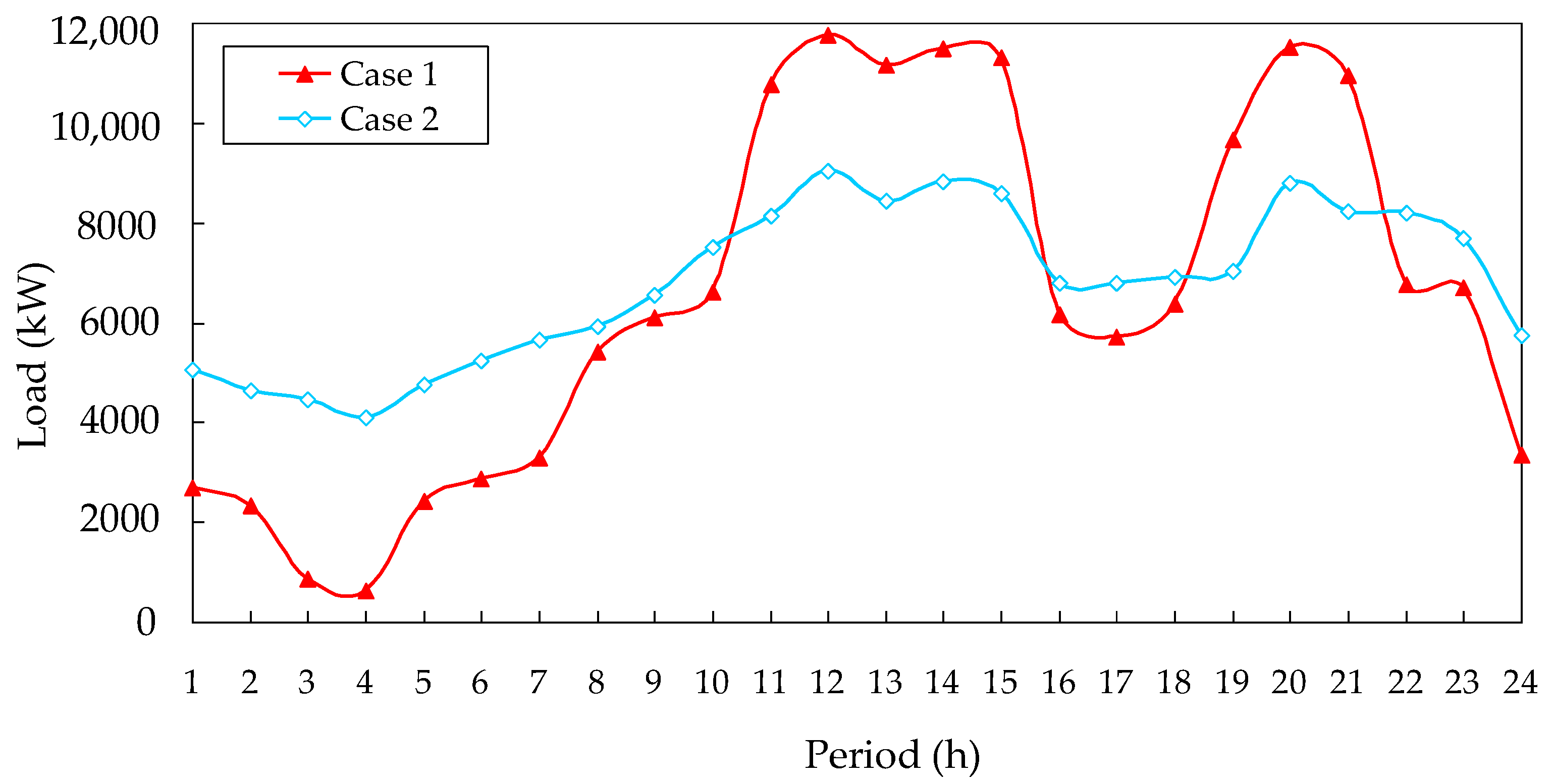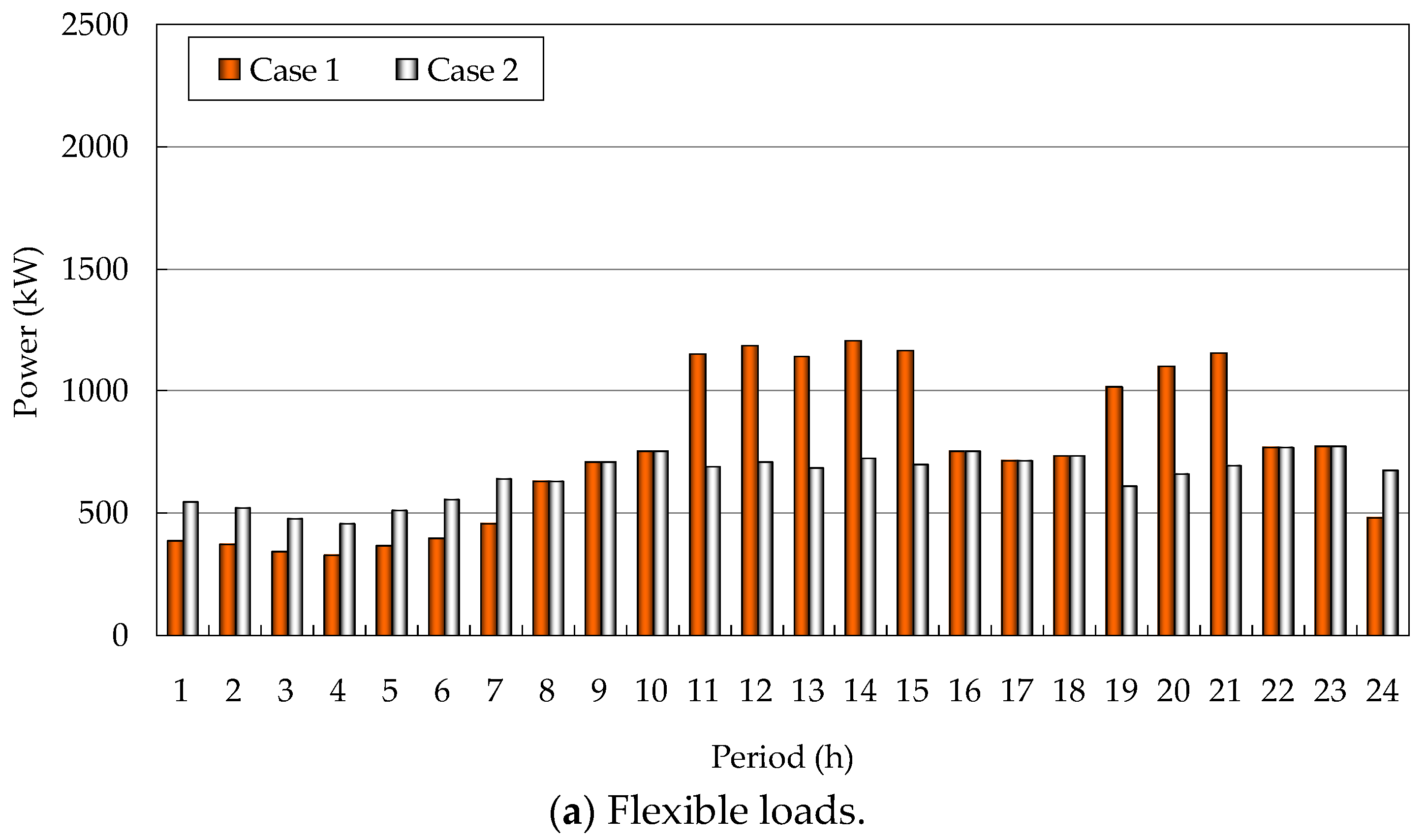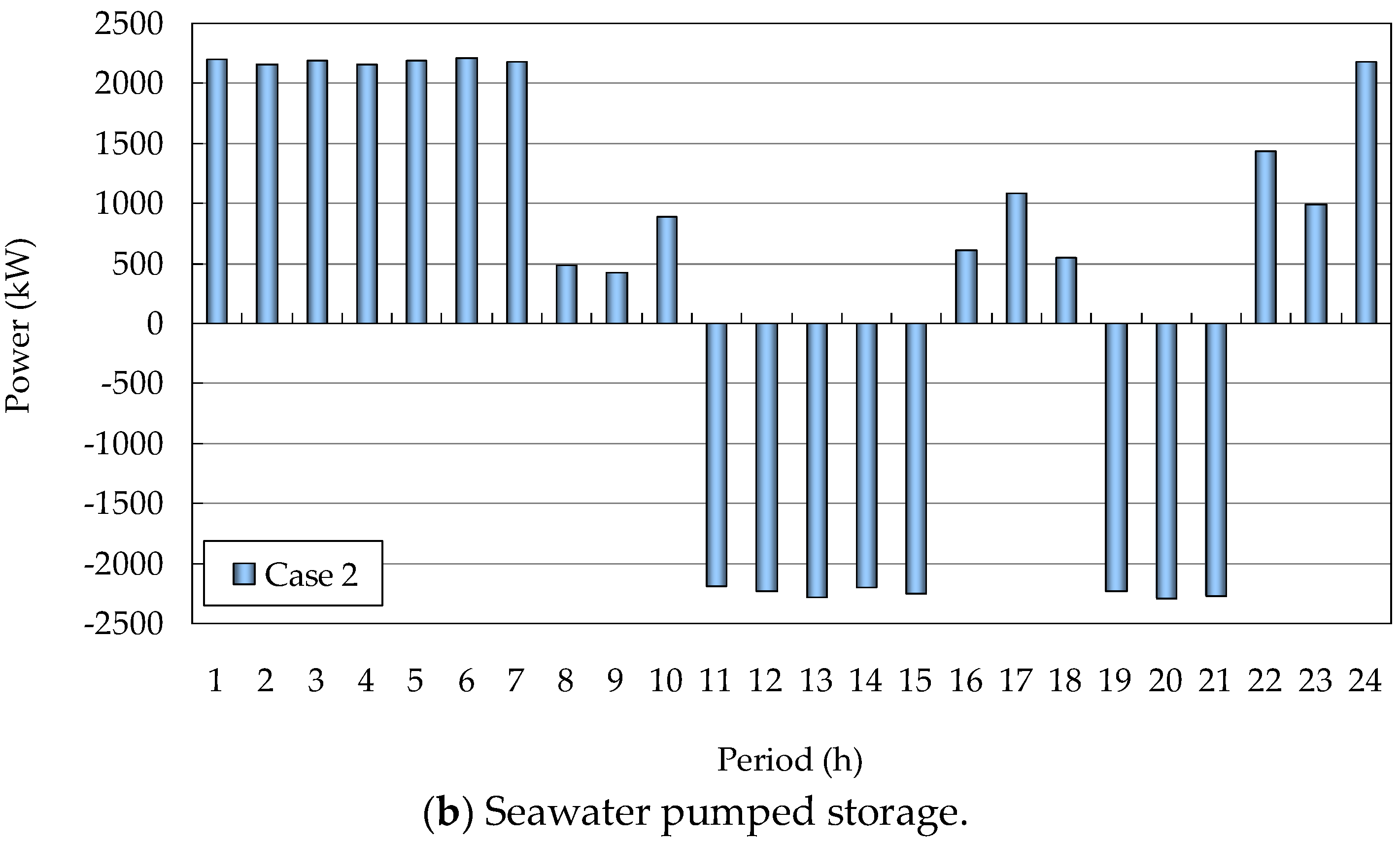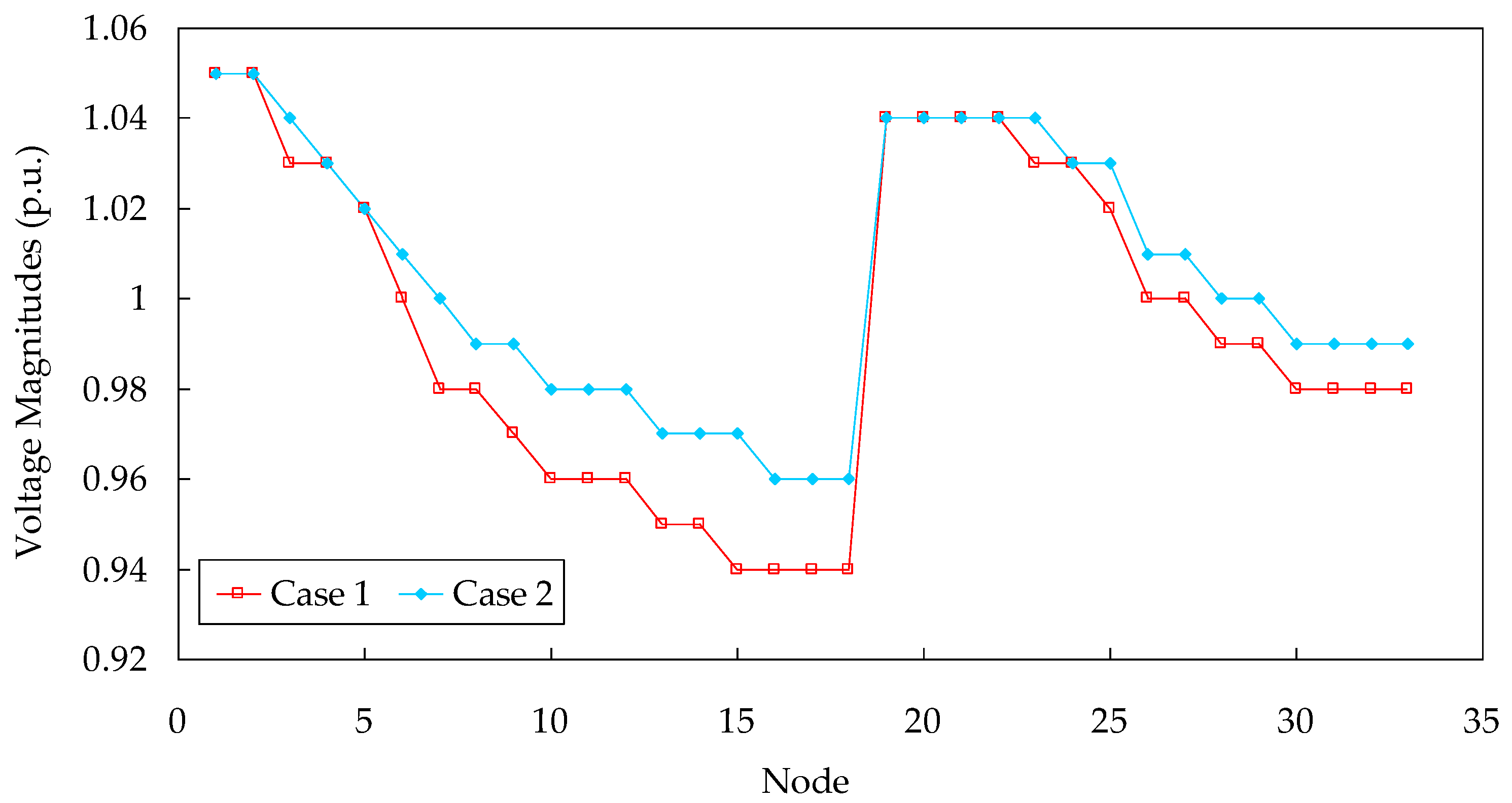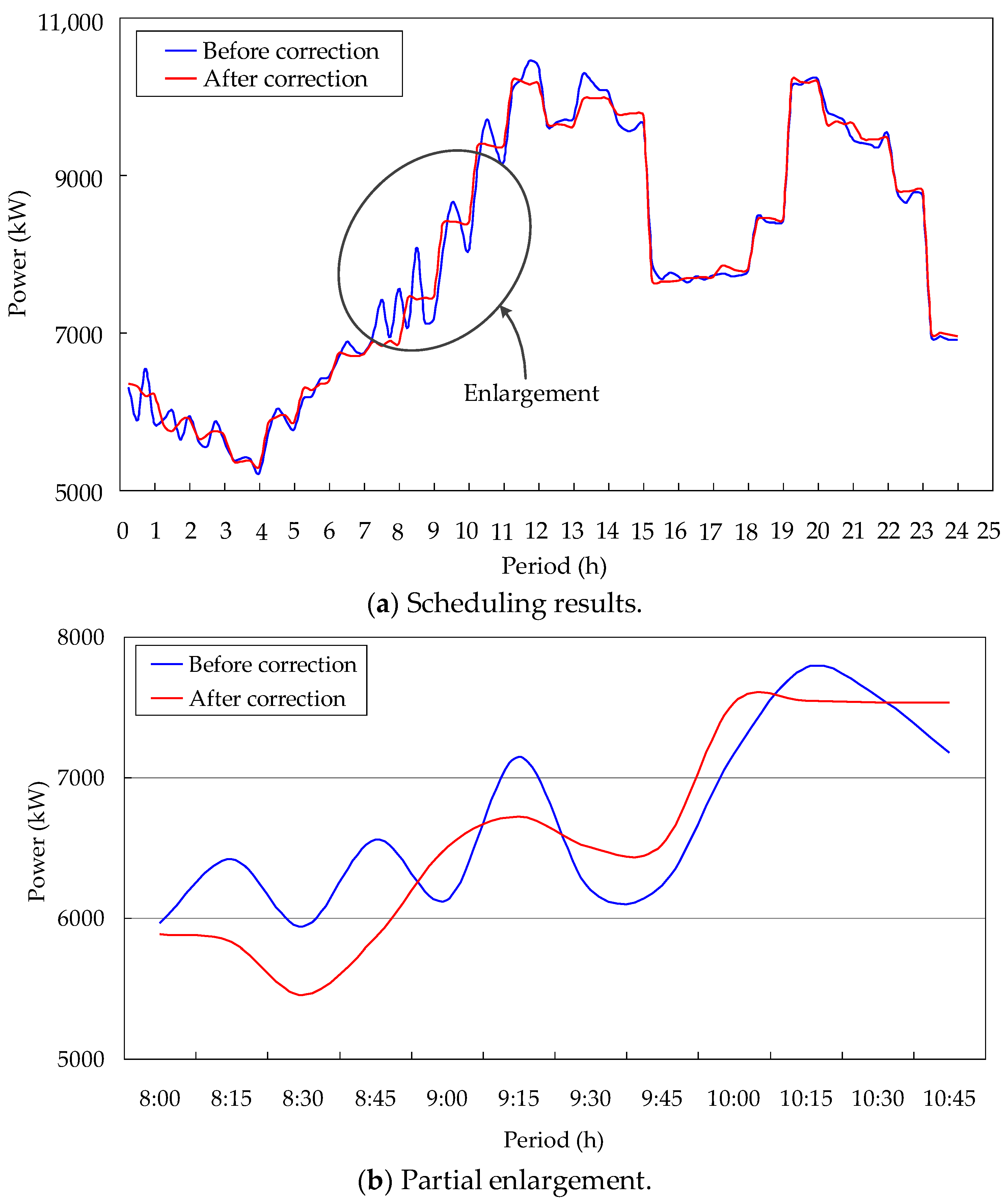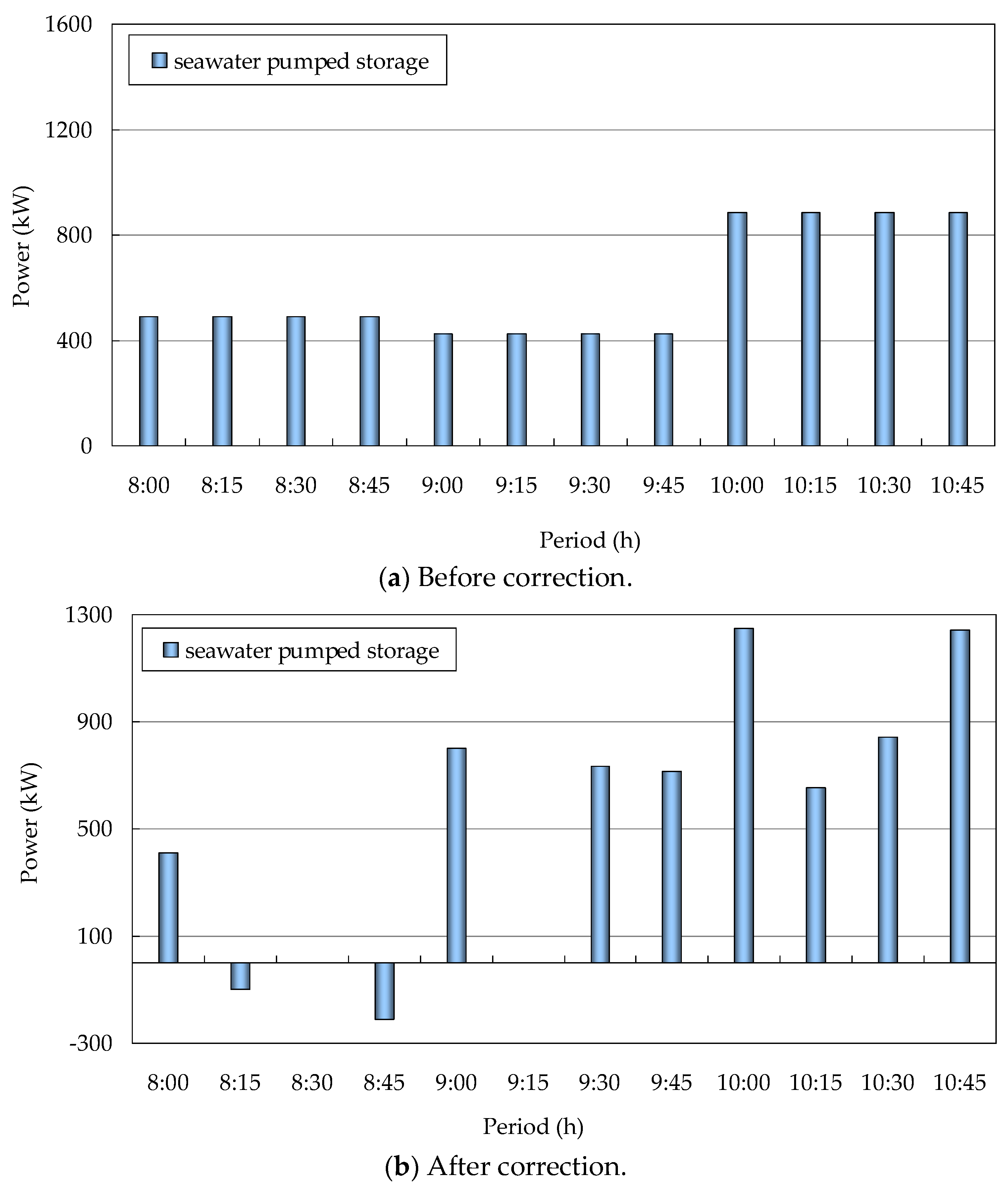1. Introduction
There are rich renewable energy resources in China offshore. In recent years, the percentage of penetration in renewable energy in distribution networks has increased dramatically [
1,
2,
3]. Power output of renewable energy generation (REG) like wind turbine (WT) generators and photo voltaic (PV) arrays have high randomness and fluctuation attributes. The controllability of WT and PV output is low [
4,
5], which rese new challenges to the operation of distribution networks. To increase its operation reliability and economy, energy storage provides an attractive solution because it has fast power response speed and strong energy shifting capabilities [
6,
7,
8]. Compared with traditional energy storage technologies such as lead acid battery banks, hydrogen energy storage, and flywheel energy storage, etc., variable speed seawater pumped storage has many advantages, such as larger storage capacity, higher energy storage efficiency, lower per kilowatt capital and maintenance costs, longer service life, and it also can provide additional inertia energy for networks [
9,
10]. Meanwhile, compared with traditional pumped storage, offshore ocean is used as the lower reservoir for variable speed seawater pumped storage. The amount of water resources are inexhaustible and total construction costs can be reduced. But how to dispatch the distribution networks that contain variable speed seawater pumped storage and REG, reaching a high operation performance and having high economic benefits, is still a problem for the network operators.
Current distribution networks were operated in a passive fashion. The traditional operating method is no longer applicable to new distribution networks which contain REG, energy storage, and flexible loads, etc. In recent years, the concept of active distribution networks was proposed [
11,
12,
13]. Compared with traditional distribution networks, this network is able to manage the power of REG, energy storage, and flexible loads actively, having the advantages of increasing the operation reliability and minimizing the total operation cost and power losses of the distribution networks [
14,
15]. Besides, the active distribution networks can provide additional spinning reserve capacities to alleviate the negative impacts of the stochastic fluctuations of REG and load demands on itself at the distribution network level. Problems of declining power quality are induced by stochastic, uncertain fluctuations of power of REG and load demands. These problems are solved locally by appropriate dispatch of distributed generators and energy storage [
16]. In the dispatch of active distribution networks, an optimization model that can both achieve a global optimal solution and provide good performance is demanded [
17]. Dynamic economic dispatch method [
18] and consensus based dispatch method [
19] can be applied to generate a dispatch schedule. However, the performance cannot meet this demand. The power flexibility and energy storability characteristics of energy storage in active distribution networks are not fully utilized in the present market management systems (MMS) and energy management systems (EMS) [
20]. Operation schedules are generally determined at day-ahead time stages, ignoring the effect of real-time adjustment which can compensate for uncertainties and forecast errors of REG [
21,
22]. Day-ahead scheduling is performed, which is based on short-term forecasts of REG and load demands. However, because of the stochastic fluctuation attributes in wind strength, illumination intensity, etc., it is difficult to make accurate short-term predictions for PV and WT power and load demands.
For reducing the impact of renewable energy sources which are connected to power systems, the two-stage optimal scheduling method has been presented by some scholars in recent years. For example, there is the disturbance of power systems caused by the randomness and volatility of wind power, which can be reduced by a two-stage dynamic scheduling method, as noted in Reference [
23]. In addition, a two-stage optimal scheduling method for micro-grid economy is presented in Reference [
24]. In the first stage, based on the real-time forecast data for future power, optimal management for power source in a micro-grid is able to be calculated. In the second stage, according to the limitation of diesel generator output which can be figured out before, the output of diesel generators is adjusted for improving the robustness of the system. The dispatch schedule is made in day-ahead for seawater pumped storage and renewable energy has not yet utilized their potential capabilities to increase the performances and economics of active distribution networks adequately. Compared to short-term forecasts, ultra-short forecasts for PV and WT power is quite accurate. Based on the ultra-short forecasts information, real-time scheduling for seawater pumped storage can solve or mitigate the negative impacts caused by forecast errors effectively. In this paper, a two-stage scheduling method is proposed, because it has high computation efficiency and takes advantages of the flexibility of seawater pumped storage and flexible loads to dispatch the active distribution networks. In a day-ahead scheduling stage, optimal dispatch schedule of active distribution networks is determined. In a real-time scheduling stage, negative impacts of forecast errors of REG on the operation of active distribution networks is compensated and mitigated.
Main contributions are as follows.
Variable speed seawater pumped storage is first utilized for dispatch in offshore local active distribution networks in China;
A two-stage scheduling method considering variable speed seawater pumped storage, flexible loads, and REG in active distribution networks is presented. Both advantages of day-ahead and real-time scheduling are fully utilized and exploited.
Remaining sections are organized as follows:
Section 2 introduces the dispatch model for variable speed seawater pumped storage.
Section 3 presents the problem formulation of the two-stage scheduling in active distribution networks and the solving algorithm.
Section 4 gives the test results of the proposed approach on a modified Institute of Electrical and Electronics Engineers (IEEE) 33-bus distribution system. Finally, conclusions are drawn in
Section 5.
2. Variable Speed Seawater Pumped Storage Model
The structure of a traditional pumped storage station consists of a generator unit, pumping station, and upper and lower reservoirs. Capacities of the upper and lower reservoirs are mainly determined by the conditions of natural water resources. However, for a variable speed seawater pumped storage station, one of the prominent features is that the lower reservoir is the sea. Its water resources are unlimited and its capacity can be considered infinitely large. Only the water amount of the upper reservoir should be considered in the optimal scheduling. Another prominent feature is that the speed of the motor rotor in generating or pumping mode can vary within a large range. Therefore, the efficiency of the overall system can be improved in the generating mode. In the pumping mode, the range of input power is expanded. From the point of view of scheduling, the above features can gain great benefits for the operation of the power system. Operation models of a variable speed seawater pumped storage station in generating and pumping modes are expressed as follows.
2.1. Generating and Pumping Modes
In the generating mode, output power is formulated by:
In the pumping mode, energy for the pump is directly input from local active distribution networks. The flow rate of seawater sucked from the sea is stated as follows.
2.2. Operation and Maintenance Cost of Seawater Pumped Storage
Seawater contains high salinity and corrosiveness to pipelines, which increases the maintenance cost of pipelines. Therefore, the cost of seawater pumped storage contains the installation fee, start-up cost, pipelines, and generator maintenance cost. Equation (3) is the operation and maintenance cost of seawater pumped storage; Equations (4) and (5) are the start-up cost of a turbine generator and pump-motor unit in period
t, respectively; Equation (6) is the maintenance cost of turbine generator and pump-motor unit in period
t; Equation (7) is the piping maintenance cost of the seawater pumped storage.
2.3. Operation Constraints of Variable Speed Seawater Pumped Storage Station
The proposed coordinate optimal scheduling models for active distribution networks containing seawater pumped storage have two stages. The first stage is the day-ahead, and the second stage is the real-time.
2.3.1. Day-Ahead Operation Constraints
In period
t, the quantity of seawater stored in upper reservoir is given as follows.
Seawater pumped storage stations can operate only in one mode in a given time interval, on-off operation mode constraint:
Power range constraint in generating mode:
Power range constraint in pumping mode:
Water amount constraint for upper reservoir:
2.3.2. Real-Time Operation Constraints
The quantity of seawater stored in upper reservoir:
On-off operation mode constraint:
Power range constraint in generating mode:
Power range constraint in pumping mode:
Water amount constraint for upper reservoir:
Restricted by technical conditions, the frequency of switching between generating and pumping modes must be limited. Minimum switching time is 30 min, (i.e., a time of 2∆
t is required). Formulation below must be satisfied in real-time scheduling.
2.3.3. Problem Formulation
Due to the stochastic fluctuation attributes in wind strength and illumination intensity, people’s ability to predict REG power output accurately has yet to be improved. Ultra-short forecasting of REG are far more accurate than short-term’s. Day-ahead scheduling of variable speed seawater pumped storage is performed based on the short-term forecast information of REG power and load demands. The objective of this stage is to minimize total system operation cost. Then real-time scheduling of variable speed seawater pumped storage is carried out based on ultra-short forecast information to mitigate the negative effects of the forecast errors on the operation of active distribution networks [
25].

